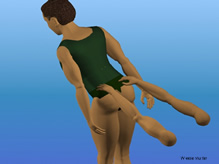U.C.L.A. Rheumatology Pathophysiology of Disease Course Lecture,
Second Year Medical School 1997
Ankylosing Spondylitis Page 19
Unlike RA, the principal target of inflammation in both AS and Reiter's Syndrome is the enthesis. This is the site of attachment of strong ligaments to bone. There is a mononuclear inflammation at this site which results in pain and spasm of the surrounding ligaments and muscles. Movement around the area is reduced. The typical patient with AS presents with pain in the low back extending up to the thoracic spine and neck (figure 1). The sacroiliac joints are inflamed since these joints are the site of strong ligaments attached to bone and fibrocartilage. As the inflammation progresses, new bone is laid down which
